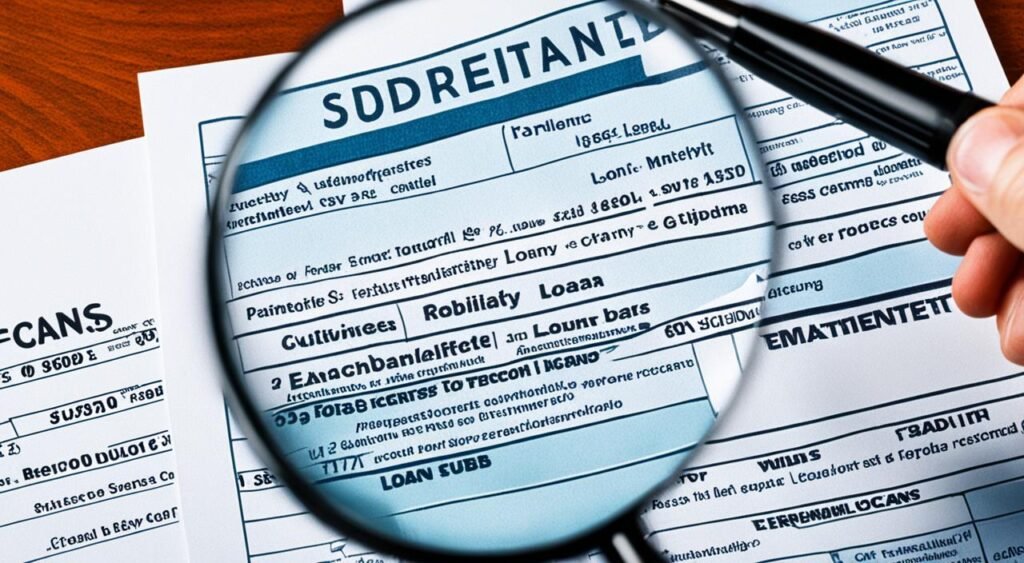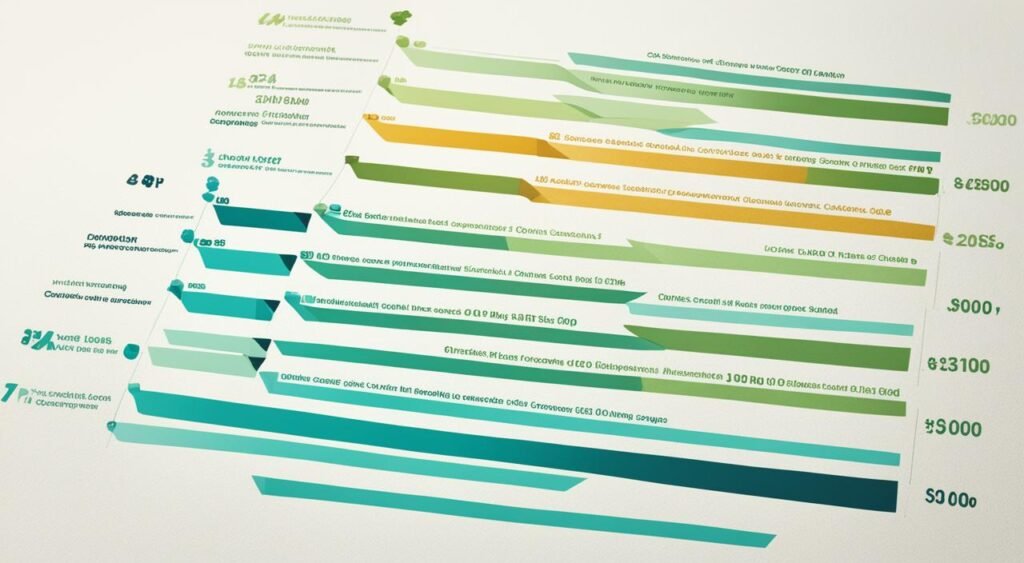Subsidized loans help undergraduate students who have financial needs. They are a type of federal student loan. The government pays the interest while the student is in school. It also helps after the student leaves school and during any breaks from paying back the loan.
These loans aim to make college less expensive for students from low-income families. They look at how much college costs, what the student’s family can pay, and other financial help. By covering the interest, students can put more focus on their classes. They won’t have to worry about repaying the loan right away.
Key Takeaways
- Subsidized loans are a type of federal student loan for undergraduate students with financial need
- The government pays the interest on subsidized loans while the student is enrolled, during the grace period, and any deferment periods
- Subsidized loans can significantly reduce the overall cost of borrowing for college compared to unsubsidized loans
- Eligibility for subsidized loans is based on the student’s financial need, as determined by the cost of attendance and expected family contribution
- Subsidized loans provide an important form of government-backed financial aid to make higher education more accessible
Understanding Subsidized Loans
Definition and Key Features
Subsidized loans help undergraduate students with financial need. They are part of federal student aid. These loans are great for students looking for affordable ways to pay for college.
The U.S. Department of Education pays the loan’s interest while you are in school at least half-time. They also cover this interest for six months after you leave school. Plus, they do this during any times you pause your payments. This reduces the cost of the loan for you.
To get a subsidized loan, your cost of attendance and other financial factors count. The interest you pay is fixed at 5.50% from July 1, 2023, to June 30, 2024. Remember, there is a limit to how much you can borrow with these loans.
| Subsidized Loan Key Features | Description |
|---|---|
| Interest Paid by Government | The U.S. Department of Education pays the interest on the loan while the student is enrolled in school at least half-time, during the 6-month grace period after leaving school, and during any deferment periods. |
| Eligibility Criteria | Determined by the student’s cost of attendance, expected family contribution, and other financial aid received. |
| Interest Rate | Fixed rate, currently 5.50% for loans disbursed from July 1, 2023, to June 30, 2024. |
| Lifetime Borrowing Limit | There is a maximum amount of subsidized loans a student can receive over their lifetime. |
It’s key to understand subsidized loans for wise educational financing decisions. They offer big financial help, making college more reachable for those who qualify.
Eligibility Criteria for subsidized loan

To get a subsidized federal student loan, you must meet certain criteria. These loans are for undergrad students with financial need. This need is figured out by the FAFSA. To be eligible, you must meet these requirements:
- Demonstrate financial need: The cost of school attendance is compared to what you and your family can pay. If there’s still a need for money, you might get a loan.
- Be enrolled at least half-time: You have to be studying at least half the time in an approved program.
- Be a U.S. citizen or eligible noncitizen: These loans are for U.S. citizens and some non-citizens, like green card holders.
- Maintain satisfactory academic progress: You need to keep up with your school work to stay eligible for the loan.
- Not have reached the maximum lifetime limit: Once you’ve borrowed up to a certain amount, you can’t get more of these loans.
Subsidized loan eligibility requirements make sure the help goes to those who need it most. They make college more within reach for students from all kinds of financial situations.
| Eligibility Criteria | Explanation |
|---|---|
| Demonstrate financial need | The student’s expected family contribution and other financial aid are subtracted from the school’s cost of attendance to calculate their remaining financial need. |
| Enrolled at least half-time | Students must be enrolled in an eligible degree or certificate program and attending school at least half-time. |
| U.S. citizen or eligible noncitizen | Subsidized loans are available to U.S. citizens and eligible non-citizens, such as permanent residents. |
| Maintain satisfactory academic progress | Students must meet their school’s standards for satisfactory academic progress to maintain eligibility. |
| Not have reached the maximum lifetime limit | There is a limit on the total amount of subsidized loans a student can receive over their lifetime. Once this limit is reached, they will no longer be eligible. |
Knowing who qualifies for subsidized loans helps students. It ensures they meet the needed conditions to get the financial help for their education.
Subsidized Loan Limits

The government places limits on subsidized loans to keep students from taking on too much debt. These limits make sure students borrow wisely to avoid big debts later on.
Annual Subsidized Loan Limits
How much a student can get in subsidized loans each year changes with their situation. For students who rely on their parents and are in their first or year of college, they can get $3,500. This amount goes up to $4,500 for second-year students. By the third and fourth years, it’s $5,500. Students who are not dependent on their parents can get bigger loans. First-year amounts jump to $9,500, then $10,500, and finally $12,500.
Aggregate Subsidized Loan Limit
On top of yearly limits, there’s a cap on how much you can borrow over four years. This limit is $23,000 for both dependent and independent students.
| Dependency Status | Annual Subsidized Loan Limit | Aggregate Subsidized Loan Limit |
|---|---|---|
| Dependent Undergraduate |
|
$23,000 |
| Independent Undergraduate |
|
$23,000 |
It’s vital that students know and follow these limits to keep debt in check. Adhering to these financial guidelines allows students to get the most from their loans. It also makes sure they don’t carry a heavy debt load after school.
How Subsidized Loans Differ from Unsubsidized Loans

There are two main types of federal student loans: subsidized and unsubsidized. They both help pay for your education. But, they work in different ways that are important to know about.
Interest Accrual
The big difference is in how interest grows. With subsidized loans, the government covers the interest while you’re in school, during the grace time, and if you defer. So, the loan doesn’t get bigger from interest during these times. Unsubsidized loans start gathering interest as soon as the money is given out. You’re the one who has to pay this interest off.
Eligibility and Borrowing Limits
Subsidized loans depend on your financial need. You’re must show need through the FAFSA to get one. For unsubsidized loans, this isn’t needed. You can borrow up to a set limit no matter your financial state.
Cost of Borrowing
Because of the interest help from the government, subsidized loans are less costly overall than unsubsidized loans. This difference can save you a lot of money over the loan’s life.
Deciding between subsidized and unsubsidized federal loans is a key step in planning how to finance your education. Subsidized loans are often the cheaper choice because of their interest-free times and need-based nature.
Applying for a subsidized loan
To get a subsidized federal student loan, you first need to fill out the FAFSA form. This form helps decide if you need financial aid and if you can get a subsidized loan. It also opens doors to other financial help for school.
The FAFSA asks about your family’s money, like income and assets. It figures out an amount your family should be able to pay for your education, called the expected family contribution (EFC).
- Be ready with important documents like your tax returns and bank statements before you start the FAFSA.
- Next, go online to the official FAFSA website and fill out the form carefully with current and correct information.
- After you submit the FAFSA, you will receive a Student Aid Report (SAR). Check the SAR to make sure everything is right.
- Colleges might need more information to finalize your financial aid. Make sure to provide any extra documents requested on time.
Filling out the FAFSA completely is crucial. It helps you qualify for a subsidized loan, which can lower your education costs.
| Step | Action |
|---|---|
| 1 | Gather necessary documents |
| 2 | Complete FAFSA online |
| 3 | Review Student Aid Report (SAR) |
| 4 | Submit additional documents, if required |
Always remember, the FAFSA is your first step to getting financial help for school. Complete it carefully and on time to improve your chances of getting support for your education.
Managing Repayment of Subsidized Loans
Repaying subsidized federal student loans is key for borrowers. You should understand the grace period first, which is a time before you start paying back.
Grace Period and Repayment Options
The grace period is about 6 months. It starts after you finish school, or you’re no longer at least half-time. During this time, you don’t have to pay your loans. It lets you find a job and set up your budget before loan payments start.
After the grace period, you need to choose a repayment plan. You can pick from standard, graduated, or income-driven plans. Each plan has different terms. You should choose the one that’s best for your money situation and future.
| Repayment Plan | Description | Eligible Loans |
|---|---|---|
| Standard Repayment Plan | Fixed monthly payments over a 10-year period | All federal student loans |
| Graduated Repayment Plan | Payments start lower and gradually increase over a 10-year period | All federal student loans |
| Income-Driven Repayment (IDR) Plans | Payments based on a percentage of discretionary income, with possible forgiveness after 20-25 years | Most federal student loans, including subsidized loans |
Choosing the right repayment plan is crucial. It helps you manage your debt well. This way, you can keep up with your financial duties and still live comfortably.
“The grace period is a crucial buffer that allows borrowers to transition smoothly into the repayment phase of their subsidized loans.”
Subsidized Loan Interest Rates and Fees
Subsidized federal student loans help students cover the costs of school. It’s important to grasp the interest rates and fees involved. These elements affect how much the loan will cost and how you pay it back.
The U.S. Department of Education sets the interest rate yearly for these loans. For loans given out between July 1, 2023, and June 30, 2024, this rate is 5.50%. It doesn’t change during the loan’s life, which helps borrowers budget.
Subsidized loans have additional fees. These are a small part of the loan total and get taken out when the money is given. For loans starting October 1, 2022, the subsidized loan fees are 1.057%.
Remember, the cost of subsidized loans changes based on how much you borrow and for how long. Even so, with a steady interest rate and low fees, these loans are cheaper than other options. This includes unsubsidized loans or borrowing from private sources.
| Loan Type | Interest Rate | Loan Fees |
|---|---|---|
| Subsidized Federal Student Loan | 5.50% | 1.057% |
Knowing about the rates and fees for subsidized loans is key. It lets students make smart financial choices and prepare well for paying back what they owe.
The Impact of Subsidized Loans on Student Debt
Federal student loans that are subsidized can really lessen a student’s debt. The government pays the loan’s interest while a student is in school or on deferment. Because of this, the amount to be paid back is much lower.
The top benefit of subsidized loans is they cut student debt. With interest paid by the government, students only need to worry about the loan’s main cost. This saves a lot of money over time, making payments easier after school.
The subsidized nature of these loans lets students focus on learning without the stress of growing interest. This can help them do better in school and earn more after they graduate. It all helps to lower the student’s debt burden.
Research shows that students with subsidized loans often have less debt at graduation. When compared to those using other loans, this difference can be large, sometimes thousands of dollars. It gives these students a good financial head start after school.
“Subsidized loans are a game-changer for students, allowing them to focus on their education without the constant worry of escalating debt. The impact on their overall financial well-being can be truly life-changing.”
In conclusion, subsidized loans greatly impact student debt. By lowering what must be paid and making finances easier, students can reach their education and career dreams without heavy debt.
Also Read: What Factors Determine Student Loan Interest Rates?
Conclusion
Subsidized federal student loans are a big help for college students with financial need. These loans have the government pay the interest. This makes it cheaper to borrow money for school, reducing the financial burden.
There are certain conditions for getting these loans. It’s important for students to look into these factors before making their decision. This includes the eligibility rules, how much they can borrow, and how they will pay the money back.
Subsidized loans offer several advantages. They lower the amount of interest you pay. They also let you choose from different ways to repay the loan. Plus, they help students learn how to borrow money wisely.
For those going to college soon or already there, subsidized loans are key in paying for school. They ease the cost of higher education. They’re a great help in reaching your school goals while keeping student debt lower.
Understanding subsidized loans is essential for making smart financial choices in your college life. By using these loans, you can concentrate on your studies. This way, you open up more doors that a college education brings.
FAQs
What are subsidized loans and how do they work?
Subsidized loans help undergraduate students with financial need. The U.S. Department of Education takes care of the interest when they are in school. This help continues after they leave school too, and even during deferment periods.
What are the key features of subsidized loans?
The main stuff to know about subsidized loans are:
– The government pays the interest at certain times.
– Students qualify based on their financial need, as shown in their FAFSA.
– These loans come with a fixed rate that was 5.50% from July 2023 to June 2024.
– And, there’s a limit on how much money students can get in subsidized loans altogether.
Who is eligible for a subsidized federal student loan?
To get a subsidized loan, undergrads must:
– Prove they need financial help through the FAFSA.
– Study at least half-time in a program that fits.
– Be a U.S. citizen or meet certain criteria.
– Keep up their grades.
– Not reach the total loan amount limit.
What are the annual and aggregate borrowing limits for subsidized loans?
There’s a cap on how much you can borrow each year and over the course of your degree. These limits change depending on your dependency status and academic level.
How do subsidized loans differ from unsubsidized loans?
Subsidized and unsubsidized loans work differently:
– The government covers the interest during school and certain other times for subsidized loans. Students pay the interest on unsubsidized loans.
– Subsidized loans are for those who need help financially. Unsubsidized loans don’t check financial need.
– Subsidized loans have a set interest rate. The rate on unsubsidized loans can change.
How do I apply for a subsidized federal student loan?
To get a subsidized loan, you must fill out the FAFSA first. Your financial need is assessed through the FAFSA. This decides if you’re eligible for the loan.
When do I begin repaying my subsidized federal student loan?
You start paying back your subsidized loan 6 months after you graduate or leave school. This window is called the grace period. It also applies if you go from being a full-time student to part-time.
What is the interest rate on subsidized federal student loans?
Subsidized loans always have a fixed rate. This rate is determined yearly by the U.S. Department of Education. The rate for loans given out from July 1, 2023, to June 30, 2024, is 5.50%.
How do subsidized loans impact the overall cost of borrowing for college?
Subsidized loans can significantly lower how much you owe overall. This is because the government handles the loan’s interest while you’re in school and sometimes after. So, you end up having to pay back less eventually.





